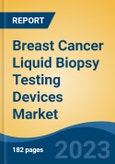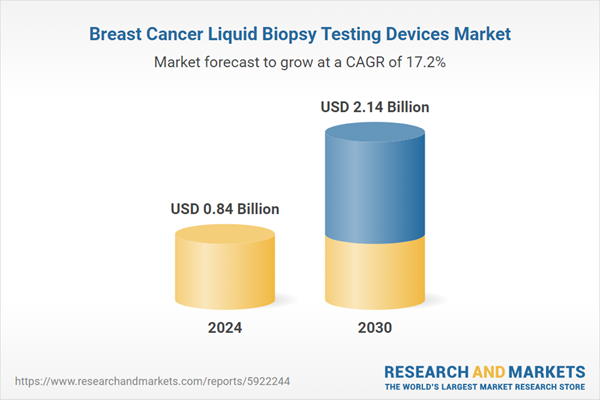Free Webex Call
The Breast Cancer Liquid Biopsy Testing Devices Market was valued at USD 0.84 Billion in 2024, and is expected to reach USD 2.14 Billion by 2030, rising at a CAGR of 17.20%. Liquid biopsy serves as a valuable asset in the realm of breast cancer diagnosis and treatment. The analysis of mutations through liquid biopsy aids in the identification of targeted therapies tailored to individual patients based on their tumor-specific genetic alterations. To illustrate, in the case of patients grappling with metastatic breast cancer, screening for the PIK3CA mutation, which is found in around 40% of HR-positive tumors, assists in determining the most effective treatment path. Speak directly to the analyst to clarify any post sales queries you may have.
10% Free customizationThis report comes with 10% free customization, enabling you to add data that meets your specific business needs.
For instance, according to the American Society of Cancer (ASC) Report 2023, breast cancer remains the most common cancer among women in the United States, excluding skin cancers. It accounts for 30% of all female cancers diagnosed annually. In an effort to reduce the prevalence and mortality rates of breast cancer, the government has implemented policies and introduced laws to support patients with the costs of diagnosis and treatment. Also, according to the World Health Organization 2023 report, more than 2.3 million cases of breast cancer are diagnosed annually, making it the most prevalent cancer among adults. However, approximately 80% of breast cancer-related deaths occur in low- and middle-income countries.
Key Market Drivers
Advancements in Cancer Detection Technology
The landscape of cancer detection and diagnosis is evolving rapidly, and one area of remarkable progress is the development of liquid biopsy testing devices. These devices, which have gained prominence in the healthcare industry, are offering a non-invasive, highly sensitive, and patient-friendly approach to detect and monitor cancer, with breast cancer being a significant focus.One of the keyways advancements in cancer detection technology are boosting the growth of the global breast cancer liquid biopsy market is by enhancing sensitivity and specificity. Liquid biopsies can now detect minute traces of circulating tumor DNA (ctDNA) or other biomarkers in a patient's bloodstream. This increased sensitivity ensures that even small tumors or minimal residual disease (MRD) can be detected accurately, which was often challenging with traditional diagnostic methods.
Key Market Challenges
Limited Sensitivity and Specificity
While liquid biopsy testing devices have advanced considerably, they may still face challenges related to sensitivity and specificity. Detecting circulating tumor DNA (ctDNA) or other biomarkers in the bloodstream can be challenging, especially for small or early-stage tumors. Improving the sensitivity and specificity of these tests remains a priority for the industry.Key Market Trends
Integration with Conventional Diagnostics
The trend is moving towards the integration of liquid biopsy testing devices with traditional diagnostic methods. Combining liquid biopsies with imaging and tissue biopsies can provide a more comprehensive understanding of the disease. This integrated approach offers greater diagnostic accuracy and opens up new avenues for treatment decisions.Key Market Players
- A Menarini AG
- NeoGenomics Laboratories Inc
- F Hoffmann-La Roche AG
- Myriad Genetics Inc
- QIAGEN NV
- Biocept Inc
- Sysmex Corp
- Fluxion Biosciences Inc
- Thermo Fisher Scientific Inc
- Epic Sciences Inc
Report Scope:
In this report, the Global Breast Cancer Liquid Biopsy Testing Devices Market has been segmented into the following categories, in addition to the industry trends which have also been detailed below:Breast Cancer Liquid Biopsy Testing Devices Market, By Offerings:
- Assay & Reagents Kits
- Instruments
Breast Cancer Liquid Biopsy Testing Devices Market, By Circulating Biomarker:
- Circulating Tumor DNA
- Circulating Tumor Cell
- Extracellular Vesicles
Breast Cancer Liquid Biopsy Testing Devices Market, By Application:
- Cancer Applications
- Non-Cancer Applications
Breast Cancer Liquid Biopsy Testing Devices Market, By Region:
- North America
- United States
- Canada
- Mexico
- Europe
- Germany
- United Kingdom
- France
- Italy
- Spain
- Asia-Pacific
- China
- Japan
- India
- Australia
- South Korea
- South America
- Brazil
- Argentina
- Colombia
- Middle East & Africa
- South Africa
- Saudi Arabia
- UAE
- Kuwait
Competitive Landscape
Company Profiles: Detailed analysis of the major companies present in the Global Breast Cancer Liquid Biopsy Testing Devices Market.Available Customizations:
With the given market data, the publisher offers customizations according to a company's specific needs. The following customization options are available for the report.Company Information
- Detailed analysis and profiling of additional market players (up to five).
This product will be delivered within 1-3 business days.
Table of Contents
1. Product Overview
2. Research Methodology
3. Executive Summary
5. Global Breast Cancer Liquid Biopsy Testing Devices Market Outlook
6. North America Breast Cancer Liquid Biopsy Testing Devices Market Outlook
7. Europe Breast Cancer Liquid Biopsy Testing Devices Market Outlook
8. Asia-Pacific Breast Cancer Liquid Biopsy Testing Devices Market Outlook
9. South America Breast Cancer Liquid Biopsy Testing Devices Market Outlook
10. Middle East and Africa Breast Cancer Liquid Biopsy Testing Devices Market Outlook
11. Market Dynamics
12. Market Trends & Developments
13. Porter’s Five Forces Analysis
14. Competitive Landscape
Companies Mentioned
- A Menarini AG
- NeoGenomics Laboratories Inc
- F Hoffmann-La Roche AG
- Myriad Genetics Inc
- QIAGEN NV
- Biocept Inc
- Sysmex Corp
- Fluxion Biosciences Inc
- Thermo Fisher Scientific Inc
- Epic Sciences Inc
Table Information
| Report Attribute | Details |
|---|---|
| No. of Pages | 180 |
| Published | March 2025 |
| Forecast Period | 2024 - 2030 |
| Estimated Market Value ( USD | $ 0.84 Billion |
| Forecasted Market Value ( USD | $ 2.14 Billion |
| Compound Annual Growth Rate | 17.2% |
| Regions Covered | Global |
| No. of Companies Mentioned | 10 |









